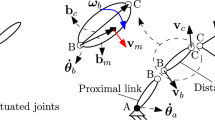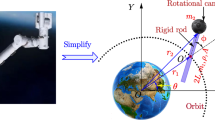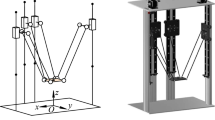Abstract
This work deals with the inverse–forward kinematic analysis of a symmetric parallel manipulator equipped with a rotary actuator generator of three independent translations and one rotation motion. The closure equations of the displacement analysis are easily formulated based on the unknown coordinates of two points embedded in the moving platform. The input–output equations of velocity and acceleration of the robot are systematically obtained through the reciprocal-screw theory. The pseudo-kinematic pairs that connect the limbs to the fixed platform and a passive kinematic chain connected to the robot manipulator eliminate the handling of rank-deficient Jacobian matrices, which is an undisputable advantage from the computational point of view. Furthermore, this strategy allows the use of the Lie algebra se(3) without the inherent restrictions associated with the limited mobility of the robot.
Similar content being viewed by others
References
C.-C. Lee and J. M. Hervé, On the enumeration of Schönflies motion generators, Proc Ninth IFToMM International Symposium on Theory of Machines and Mechanisms, Bucharest, Romania, September 1-4 (2005).
C.-C. Lee and J. M. Hervé, Isoconstrained parallel generators of Schoenflies motion, ASME J. Mech. Rob. (2011) 3: Paper 021006-021006-10, Doi: 10.1115/1.4003690.
F. Pierrot et al., Optimal design of a 4-DOF parallel manipulator: From academia to industry, IEEE Trans Rob., 25 (200) 212–224, Doi: 10.1109/TRO.2008.2011412.
V. Rosenzveig, S. Briot and P. Martinet, Minimal representation for the control of the Adept Quattro with rigid platform via leg observation considering a hidden robot model, Proc IEEE/RSJ International Conference on Intelligent Robots and Systems (IROS), Tokyo, Japan (2013) November 3-7, Doi: 10.1109/IROS.2013.6696387.
E. Özgür et al., A vision-based generic dynamic model of PKMs and its experimental validation on the Quattro parallel robot, Proc. IEEE/ASME International Conference on Advanced Intelligent Mechatronics (AIM), Besancon, France, July 8-11 (2014).
R. D. Clavel, A fast robot with parallel geometry, Proc 18th International Symposyum on Industrial Robots, Lausanne: IFS Publications, April (1988).
Z. Huang and Q. C. Li, Symmetrical lower-mobility parallel mechanisms using the constraint-synthesis method, Int. J. Robot Res., 22 (2003) 59–79.
X. Kong and C. M. Gosselin, Type synthesis of 3T1R 4-DOF parallel manipulators based on screw theory, IEEE Trans Robot Autom, 20 (2004) 181–190, Doi: 10.1109/TRA.2003.820853.
Q. Li and J. M. Hervé, Parallel mechanisms with bifurcation of Schönflies motion, IEEE Trans. Rob., 25 (2009) 158–163, Doi: 10.1109/TRO.2008.2008737.
X. Kong and C. Gosselin, Forward displacement analysis of a quadratic 4-DOF 3T1R parallel manipulator, Meccanica, 46 (2011) 147–154, Doi: 10.1007/s11012-010-9406-9.
O. Altuzarra et al., Optimal dimensioning for parallel manipulators: Workspace, dexterity, and energy, ASME J. Mech. Des., 133 (2011) Paper 041007, Doi: 10.1115/1.4003879.
S. Amine, M. T. Masouleh, S. Caro and P. Wenger, Singularity conditions of 3T1R parallel manipulators with identical limb structures, ASME J. Mech. Robot, 4 (2012) Paper 011011, Doi: 10.1115/1.4005336.
S. Liu et al., Optimal design of a 4-DOF SCARA type parallel robot using dynamic performance indices and angular constraints, ASME J. Mech. Robot, 4 (2012) Paper 031005, Doi: 10.1115/1.4006743.
C. Alessandro and S. Rosario, Elastodynamic optimization of a 3T1R parallel manipulator, Mech. Mach Theory, 73 (2014) 184–196, Doi: http://dx.doi.org/10.1016/j.mechmachtheory. 2013.10.010.
F. Xie and X.-J. Liu, Design and development of a highspeed and high-rotation robot with four identical arms and a single platform, ASME J. Mech. Robot, 7 (2015) Paper JMR-14-1117, Doi: 10.1115/1.4029440.
J. Angeles, S. Caro, W. Khan and A. Morozov, The design and prototyping of an innovative Schoenflies motion generator, Proc Instn Mech Eng Part C: J of Mechanical Engineering Science, 220 (2006) 935–944, Doi: https://hal.archivesouvertes. fr/hal-00463717.
P.-C. Lee and J.-J. Lee, On the kinematics of a new parallel mechanism with Schoenflies motion, Robotica, 34 (2016) 2056–2070, Doi: https://doi.org/10.1017/S0263574714002732.
L. Nurahmi et al., Reconfiguration analysis of a 4-RUU parallel manipulator, Mech Mach Theory, 96 (2016) 269–289, Doi: http://dx.doi.org/10.1016/j.mechmachtheory.2015.09.004.
X. Kong and C. M. Gosselin, Type Synthesis of Parallel Mechanisms, Springer, New York: N.Y. (2007).
A. Gallardo-Alvarado, A simple method to solve the forward displacement analysis of the general six-legged parallel manipulator, Robot CIM-Int. Manuf., 30 (2014) 55–61, Doi: http://dx.doi.org/10.1016/j.rcim.2013.09.001.
J. Gallardo-Alvarado et al., A simple approach to solving the kinematics of the 4-UPS/PS (3R1T) parallel manipulator, J. Mech. Sci. Technol., 30 (2016) 2303–2309, Doi: 10.1007/s12206-016-0439-4.
J.-P. Merlet, Manipulateurs paralleles, 4eme partie: Mode dassemblage et cinematique directe sous forme polynomiale, INRIA Research Report no. 1135, Centre de Sophia Antipolis, Valbonne (1989).
L.-W. Tsai, Robot Analysis, Wiley, New York: NY (1999).
J. Gallardo-Alvarado, R. Rodriguez-Castro and Md. N. Islam, Analytical solution of the forward position analysis of parallel manipulators that generate 3-RS structures, Adv Robotics, 22 (2008) 215–234, Doi: http://dx.doi.org/10.1163/156855308X292556.
M. T. Masouleh et al., Solving the forward kinematic problem of 4-dof parallel mechanisms (3T1R) with identical limb structures and revolute actuators using the linear implicitization algorithm, Proc ASME 2011 International Design Engineering Technical Conference and Information in Engineering Conference, Washington, August 28-31 (2011), Doi: 10.1115/DETC2011-47884.
I. A. Bonev, D. Zlatanov and C. M. Gosselin, Singularity analysis of 3-dof planar parallel mechanisms via screw theory, ASME J. Mech. Des., 125 (2003) 573–581, Doi: 10.1115/1.1582878.
R. S. Ball, Treatise on the Theory of Screws, Cambridge University Press: New York (1900) (Reprint 1998).
K. Sugimoto and J. Duffy, Application of linear algebra to screw systems, Mech. Mach Theory, 17 (1982) 73–83, Doi: http://dx.doi.org/10.1016/0094-114X (82)90025-8.
J. M. Rico and J. Duffy, An application of screw algebra to the acceleration analysis of serial chains, Mech. Mach Theory, 31 (1996) 445–457, Doi: http://dx.doi.org/10.1016/0094-114X(95)00089-H.
J. Gallardo-Alvarado, Kinematic Analysis of Parallel Manipulators by Algebraic Screw Theory, 1st Ed., Springer International Publishing (2016).
J. J. Cervantes-Sánchez, J. M. Rico-Martínez and V. H. Pérez-Muñoz, An integrated study of the workspace and singularity for a Schönflies parallel manipulator, J. Appl. Res. Tech., 14 (2016) 9–37, Doi: http://dx.doi.org/10.1016/j.jart. 2016.01.004.
S. Amine et al., Singularity analysis of the 4 RUU parallel manipulator using Grassmann-Cayley algebra, Trans. Can Soc. Mech. Eng., 35 (2011) 515–528.
J. Gallardo-Alvarado, H. Orozco-Mendoza and R. Rodríguez-Castro, Finding the jerk properties of multibody systems using helicoidal vector fields, Proc. Instn. Mech. Eng. Part C: J. of Mechanical Engineering Science, 222 (2008) 2217–2229, Doi: 10.1243/09544062JMES1030.
H. B. Choi and J. Ryu, Singularity analysis of a four degree-of-freedom parallel manipulator based on an expanded 6x6 Jacobian matrix, Mech. Mach Theory, 57 (2012) 51–61, Doi: http://dx.doi.org/10.1016/j.mechmachtheory.2012.06.008.
A. Johnson, X. Kong and J. Ritchie, Determination of the workspace of a three-degrees-of-freedom parallel manipulator using a three-dimensional computer-aided-design software package and the concept of virtual chains, ASME J. Mech. Robot, 8 (2015) Paper JMR-15-1025, Doi: 10.1115/1.4031656.
Author information
Authors and Affiliations
Corresponding author
Additional information
Recommended by Associate Editor Kyoungchul Kong
Jaime Gallardo–Alvarado received his B.Sc. and M.Sc. degrees in mechanical engineering from Instituto Tecnológico de Celaya, México in 1985 and 1988, respectively, and his Ph.D. in electrical engineering from Instituto Tecnológico de la Laguna, México in 1999. He is the author of the book “Kinematic Analysis of Parallel Manipulators by Algebraic Screw Theory”. He had authored more than 50 journal articles, and his interests cover spatial kinematics and dynamics of robot manipulators by means of screw theory. Dr. Gallardo–Alvarado is currently a Full-time Professor in the Department of Mechanical Engineering of the Instituto Tecnológico de Celaya and member of the SNI of México.
Mario A. García–Murillo received his degree in Mechanical Engineering from Universidad Autónoma Chapingo in 2008. In 2010, he obtained his M.Sc. in mechanical engineering from Instituto Tecnológico de Celaya in México. He earned his Ph.D. from IPN CICATA Querétaro in 2014. Dr. García–Murillo is currently a Full-time Professor in the Department of Mechanical Engineering of the Universidad de Guanajuato and member of the SNI of México. His current research interests include kinematics and dynamics of manipulators.
Md. Nazrul Islam received his B.Sc. and M.Sc. degrees in mathematics from the University of Dhaka, Bangladesh, in 1992 and 1994, respectively, M.Phil. in mathematics from the Bangladesh University of Engineering and Technology, Bangladesh, in 1998, and Ph.D. degree in system design engineering from the University of Fukui, Japan in 2008. He had authored more than 35 journal and conference papers, and his interests include big data, IoT, robotics, artificial intelligence, simultaneous localization and mapping, and fluid dynamics. Dr. Md. Nazrul Islam is a Full-time Associate Professor at the Computer Engineering Program, Faculty of Engineering in the University Malaysia Sabah, Malaysia.
Mohammad H. Abedinnasab received his Ph.D. from Sharif University of Technology, Iran, in 2012. He is an Assistant Professor and the Director of the Surgical Robotics Laboratory in the Department of Biomedical Engineering at Rowan University, USA. His research interests include kinematic and dynamic analyses of parallel manipulators, surgical robotics, biomechanics, and fuzzy controllers.
Rights and permissions
About this article
Cite this article
Gallardo-Alvarado, J., García-Murillo, M.A., Islam, M.N. et al. Kinematics of the 4-RUU parallel manipulator generator of the Schönflies motion by means of screw theory. J Mech Sci Technol 31, 4925–4932 (2017). https://doi.org/10.1007/s12206-017-0941-3
Received:
Revised:
Accepted:
Published:
Issue Date:
DOI: https://doi.org/10.1007/s12206-017-0941-3




